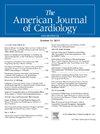Prognostic Value of Incidental Coronary Artery Calcifications in Computed Tomography Pulmonary Angiography for Suspected Pulmonary Embolism
IF 2.3
3区 医学
Q2 CARDIAC & CARDIOVASCULAR SYSTEMS
引用次数: 0
Abstract
Computed tomography (CT) has emerged as a noninvasive method to identify coronary artery calcifications (CAC). We sought to investigate the association between opportunistic visual CAC evaluation in patients without known coronary artery disease who underwent CT pulmonary angiography (CTPA) for pulmonary embolism (PE) suspicion, and cardiovascular prognosis. We analyzed data of patients who underwent CTPA for suspected PE in 2017 at CHU Dupuytren, Limoges, France. Patients were categorized into 4 groups according to a simple visual ordinal score to assess the extent and severity of CAC on a whole-patient basis: none (grade 0), mild (grade 1), moderate (grade 2), and severe (grade 3). The primary outcome was a composite of cardiovascular mortality, myocardial infarction (MI), or coronary revascularization. The secondary outcomes were all-cause mortality, and an extended composite outcome including cardiovascular mortality, MI, coronary revascularization, ischemic stroke, ischemic peripheral events, and hospitalization for heart failure. A total of 414 patients (mean age 69.7 ± 14.3 years, 42% men, 18.1% PE) were included in the analysis and subdivided according to CAC categories as follows: grade 0 (n = 123; 29.7%), grade 1 (n = 133; 32.1%), grade 2 (n = 79; 19.1%) and grade 3 (n = 79; 19.1%). The mean follow-up was 3.5 ± 2.4 years. After adjustment, the presence of CAC grade 2 to 3 CAC independently predicted the primary outcome (hazard ratio [HR] = 5.30, 95% CI 2.56 to 10.98, p <0.001). CAC grade 2 to 3 were also independent predictors for all-cause mortality (HR = 1.52, 95% CI 1.10 to 2.11, p = 0.011); and the extended composite event (HR = 1.82, 95% CI 1.13 to 2.95, p = 0.014). In conclusion, the opportunistic assessment of CAC in CTPA for suspected PE could provide important mid-term prognostic information, independently from the PE findings.
计算机断层扫描肺血管造影中疑似肺栓塞的偶然冠状动脉钙化的预后价值
计算机断层扫描(CT)已成为识别冠状动脉钙化(CAC)的一种无创方法。我们试图研究因怀疑肺栓塞(PE)而接受 CT 肺血管造影术(CTPA)的无已知冠状动脉疾病患者的机会性肉眼 CAC 评估与心血管预后之间的关联。我们分析了法国利摩日杜普伊特伦医院(CHU Dupuytren)2017年因怀疑肺栓塞而接受CTPA检查的患者数据。根据简单的视觉序数评分来评估整个患者的CAC范围和严重程度,将患者分为四组:无(0级)、轻度(1级)、中度(2级)和重度(3级)。主要结果是心血管死亡率、心肌梗死(MI)或冠状动脉血运重建的综合结果。次要结果是全因死亡率,以及包括心血管死亡率、心肌梗死、冠状动脉血运重建、缺血性中风、缺血性外周事件和心力衰竭住院在内的扩展复合结果。共有 414 名患者(平均年龄为 69.7±14.3 岁,42% 为男性,18.1% 为 PE)被纳入分析,并根据 CAC 类别细分如下:0 级(123 人;29.7%)、1 级(133 人;32.1%)、2 级(79 人;19.1%)和 3 级(79 人;19.1%)。平均随访时间为 3.5±2.4 年。经调整后,2-3级CAC的存在可独立预测主要结局(HR=5.30,95%CI 2.56-10.98;P<0.05)。
本文章由计算机程序翻译,如有差异,请以英文原文为准。
求助全文
约1分钟内获得全文
求助全文
来源期刊

American Journal of Cardiology
医学-心血管系统
CiteScore
4.00
自引率
3.60%
发文量
698
审稿时长
33 days
期刊介绍:
Published 24 times a year, The American Journal of Cardiology® is an independent journal designed for cardiovascular disease specialists and internists with a subspecialty in cardiology throughout the world. AJC is an independent, scientific, peer-reviewed journal of original articles that focus on the practical, clinical approach to the diagnosis and treatment of cardiovascular disease. AJC has one of the fastest acceptance to publication times in Cardiology. Features report on systemic hypertension, methodology, drugs, pacing, arrhythmia, preventive cardiology, congestive heart failure, valvular heart disease, congenital heart disease, and cardiomyopathy. Also included are editorials, readers'' comments, and symposia.
 求助内容:
求助内容: 应助结果提醒方式:
应助结果提醒方式:


